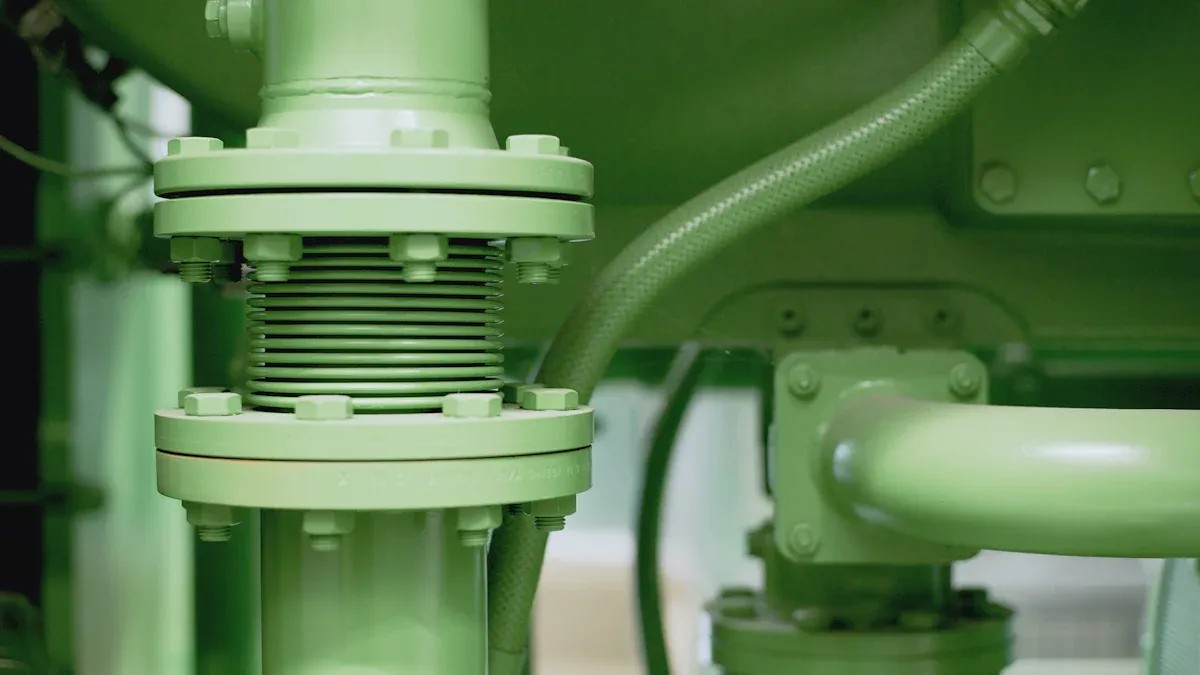Step-by-Step Guide to Picking the Right Nitinol Tubing

Nitinol tubing is a special material with amazing features. It can remember shapes and is super flexible. Nitinol is very important in healthcare, especially for small surgeries. Its bendability and strength make it perfect for tools like stents, wires, and tubes. Outside healthcare, nitinol is changing fields like airplanes and cars. It handles high stress and heat very well. Picking the right tubing helps things work better. This choice affects how well your project works and keeps people safe.
Key Takeaways
Know what your project needs before picking nitinol tubing. Think about things like heat and chemical exposure.
Follow safety and quality rules for your tubing. Meeting standards like ASTM F2063 builds trust and lowers risks.
Pick the right nitinol tubing type. Seamless tubing is strong for medical tools. Welded tubing works for bigger, less important uses.
Test nitinol tubing samples to check if they work well. This finds problems early and makes sure they work right.
Ask manufacturers for help. Their advice can help you choose the best tubing for your needs.
Understanding Application Needs
When choosing nitinol tubing, knowing your needs is key. Nitinol's special traits, like flexibility and shape memory, make it great for many uses, especially in healthcare. But these features need careful thought about the environment, physical demands, and rules.
Environmental Conditions
Temperature and Corrosion Resistance
Nitinol works well in tough conditions, but heat changes its behavior. When stretched, nitinol heats up as it changes phases. This affects how it handles stress and strain. For medical tools, knowing the Austenite Finish temperature is important. It helps the material switch to its high-heat form and return to its shape. This is crucial for stents, which must work perfectly in the body.
Exposure to Chemicals or Fluids
Nitinol resists rust, making it good for harsh settings. In healthcare, nitinol often touches body fluids. Testing ensures it stays strong and works well over time. This toughness is important for medical tools to last long and work safely.
Physical Requirements
Dimensional Tolerances
Exact sizes are very important for nitinol tubing. The process must control the size and thickness ratio for each use. For example, adjusting die sizes during making ensures the tubing works right. This accuracy is vital for medical tools, where small errors can cause problems.
Strength and Flexibility Needs
Nitinol's strength and bendability suit tough jobs. Stretch tests check its strength and how much it can stretch without breaking. These tests make sure nitinol tubing can handle stress in its job, whether in medical tools or other uses.
Compliance Standards
Industry-Specific Regulations
Some industries, like healthcare, need nitinol tubing to follow strict rules. Standards like ASTM F2063 set guidelines for testing and quality. Following these rules builds trust and lowers the chance of failures.
Medical-Grade Certifications
Medical tools need strict checks to ensure they are safe. Tests like strength checks and heat analysis prove the material works well. These certifications help nitinol tubing meet industry needs and show it is high quality.
Key Properties of Nitinol Tubing

Shape Memory and Superelasticity
How shape memory works
Nitinol can return to its original shape after bending. This happens because its crystal structure changes when heated. It shifts from one phase to another, helping it "remember" its shape. This makes nitinol tubing great for precise tools like stents. For example, stents made from nitinol expand with body heat to fit arteries.
Applications requiring superelasticity
Nitinol can bend a lot and still return to shape. This is useful for medical tools like guidewires that need to be flexible. Tests show nitinol handles stress well, making it reliable for tough jobs. It’s also used in robots and cars, where its flexibility improves performance.
Biocompatibility
Importance in healthcare applications
Nitinol is safe for the body, so it’s used in implants. It reduces risks of bad reactions when inside the body. This makes it perfect for stents that need to work safely for a long time. Nitinol stays strong even in body fluids, making it dependable.
Testing for biocompatibility
Nitinol is tested to ensure it’s safe and won’t rust. These tests prove it works well in the body without causing harm. For example, nitinol in stents is tested to meet strict medical rules. This ensures it’s safe for surgeries and other uses.
Durability and Corrosion Resistance
Long-term performance in harsh environments
Nitinol lasts a long time and doesn’t rust easily. In medical tools, it stays strong even in body fluids. This helps devices like stents work well over time. In cars and planes, nitinol handles heat and stress without breaking.
Comparison with other materials
Nitinol is stronger and lasts longer than many materials. It has fewer weak spots, making it more durable. Cleaner types of nitinol are made to last even longer. Whether in medical tools or machines, nitinol’s strength and flexibility make it the best choice.
Types of Nitinol Tubing

Choosing the right nitinol tubing means knowing the types available. Each type has special features and works best for certain tasks.
Seamless vs. Welded Tubing
Why seamless tubing is better
Seamless nitinol tubing has no welded joints. This makes it stronger and less likely to break. It’s great for important medical tools like stents and implants. Without welds, it has fewer weak spots, making it last longer. For jobs needing high precision and strength, seamless tubing is the top pick.
Uses for welded tubing
Welded nitinol tubing is made by joining edges together. This allows for bigger sizes and more complex shapes. It’s often used in cars and airplanes. For example, it works well in exhaust systems and strong parts. While not as strong as seamless tubing, it’s cheaper for less demanding tasks.
Type of Nitinol Tubing | Best Uses | Industries |
|---|---|---|
Seamless Tubes | Strong, reliable, stents, implants | Medical |
Welded Tubes | Big shapes, cars, planes | Automotive, Aerospace |
Thin-Walled vs. Thick-Walled Tubing
Why choose thin-walled tubing
Thin-walled nitinol tubing is light and very flexible. It’s perfect for tools needing precision and easy movement. In healthcare, it’s used in catheters and guidewires. Its light weight also makes it useful for robots and advanced devices.
Strength of thick-walled tubing
Thick-walled nitinol tubing is stronger and lasts longer. It’s used where high pressure or stress is common. For example, it’s great for airplane parts and strong medical tools like bone implants. Its tough design ensures it works well in hard conditions.
Custom vs. Standard Tubing
Why pick custom tubing
Custom nitinol tubing is best for unique needs. Companies like Fort Wayne Metals and GEE SMA make tubing to fit specific tasks. If you need exact sizes or special shapes, custom tubing is the way to go. For example, heart devices often need custom tubing for better performance.
Benefits of standard tubing
Standard tubing is cheaper and ready to use for common tasks. It’s good for projects that don’t need special designs. Standard tubing is reliable and works well for many industries.
Manufacturer | Key Features | Customization Approach |
|---|---|---|
Fort Wayne Metals | High precision, strict quality checks | Works closely with clients to meet specific needs. |
GEE SMA | Advanced methods, top quality | Focuses on customer satisfaction and unique designs. |
Tip: Always check your project’s needs before choosing custom or standard tubing. This helps you get the best results and value for your money.
Step-by-Step Selection Guide
Understand Your Application Needs
Know environmental and physical conditions
First, think about where the nitinol tubing will be used. For example, in healthcare, stents and guidewires must handle body fluids and keep their shape. Look at factors like temperature changes, chemical exposure, or rust resistance. Also, check the tubing's strength and flexibility. Medical tools like catheters need to be very flexible and have exact sizes to work well.
Follow compliance rules
Meeting industry rules ensures safety and good performance. In healthcare, nitinol tubing must pass tests like ASTM F2063 to prove its quality. These rules confirm the material is safe for implants or stents. Ignoring these rules can cause problems, especially in important uses.
Check Material Features
Test shape memory and flexibility
Nitinol has special traits like shape memory and superelasticity. Tests like DSC and BFR check these features. For instance, DSC finds out how heat affects the tubing. Shape memory helps the tubing return to its shape, and flexibility lets it bend without breaking. These are important for tools like guidewires.
Test Name | What It Checks | Standard |
|---|---|---|
Differential Scanning Calorimeter (DSC) | Finds heat-related changes in nitinol | ASTM F2004 |
Bend Free Recovery (BFR) | Tests shape recovery after bending | ASTM F2082 |
Tensile Testing | Measures strength and stretching ability | ASTM F2516 |
Ensure safety and durability
Safety is key for medical tools. Nitinol tubing is tested to make sure it’s safe for the body. Cleaning and polishing remove dirt, making it last longer and resist rust. These steps help the tubing work well in tough places, like inside the body or in machines.
Pick the Best Tubing Type
Choose between seamless and welded
Seamless tubing is stronger and better for medical tools like stents. Welded tubing costs less and works for simpler jobs, like car or airplane parts. Pick the type that fits your project’s needs.
Match wall thickness to the job
Thin walls are light and flexible, great for catheters and guidewires. Thick walls are stronger and better for high-pressure jobs like bone implants. Always pick the right thickness for your project to get the best results.
Tip: Work with tubing makers to design what you need. This helps you get the best tubing for your project.
Consult with Experts
Get help from manufacturers
When picking the right nitinol tubing, ask manufacturers for help. They know a lot about nitinol and its uses. Their advice can match your project’s needs perfectly.
Manufacturers focus on quality and follow strict rules. This ensures the tubing works as expected.
They can create custom solutions, like seamless tubing for implants or thick-walled tubing for tough jobs.
Their knowledge helps them suggest the best tubing for your needs.
Talking to manufacturers gives you useful tips to make choosing easier. They also guide you on meeting safety and industry rules.
Tip: Write down questions before contacting manufacturers. This helps you get clear answers quickly.
Try samples for testing
Testing samples is an important step when choosing nitinol tubing. Samples let you check how the tubing works in real situations. This makes sure it fits your project’s needs.
Ask for samples that match what you need. For example, if it’s for medical tools, request medical-grade samples. Test these for shape memory, flexibility, and rust resistance.
Note: Testing finds problems early, so your project doesn’t fail later.
Working with manufacturers during testing is helpful too. They can give advice and suggest changes to improve results. This teamwork helps you pick tubing that works best.
Common Mistakes to Avoid
Avoiding mistakes when picking nitinol tubing helps your project succeed. Errors can cause poor results, safety issues, or higher costs later. Here are common mistakes to watch for:
Ignoring Specific Needs
Forgetting environmental factors
Think about where the tubing will be used. In healthcare, nitinol often touches body fluids. Ignoring this can cause rust or make it weaker. Temperature changes can also affect its shape memory. If you skip these details, the tubing might not work well. This is especially risky for tools like stents or guidewires.
Misjudging physical demands
Each job has different needs. Picking tubing that’s too weak or stiff can cause problems. For example, catheters need to be flexible and have exact sizes. Choosing the wrong tubing can make the device fail. Always match the tubing’s strength and flexibility to your needs.
Skipping Compliance Rules
Ignoring industry standards
Following rules is very important, especially in healthcare. Standards like ASTM F2063 check the quality and safety of nitinol tubing. Ignoring these rules can lead to big problems. For example, failing audits can cause recalls or harm patients, which damages trust.
Avoiding biocompatibility tests
Medical tools must be safe for the body. Skipping these tests can cause bad reactions or failures. For instance, stents need strict testing to prove they’re safe for long-term use. Ignoring this step can risk patient safety and lead to legal trouble.
Choosing Based on Price Only
Problems with cheap options
Nitinol costs more than other materials, but it’s worth it. Cheaper tubing often lacks the needed strength or flexibility. This can cause early failures, especially in medical tools.
Long-term effects of bad choices
Picking tubing just because it’s cheap can cost more later. Making nitinol is expensive due to its complex process and material costs. But high-quality tubing lasts longer and works better. Spending more upfront saves money over time and ensures reliable devices.
Tip: Don’t just look at price. Good nitinol tubing costs more but lasts longer and works better.
Picking the right nitinol tubing starts with knowing your project needs. Whether in healthcare or other fields, think about the environment, physical demands, and rules. These factors help the tubing work properly. Nitinol has special traits like shape memory, flexibility, and body safety. These make it perfect for medical tools like stents and wires. You can choose seamless or welded tubing, thin or thick walls, and custom or standard designs to fit your needs.
Getting good materials and custom options is very important. Trusted makers give high-quality tubing in many sizes and finishes to match different jobs.
Key Point | Description |
|---|---|
Reliable Nitinol Sourcing | Ensures steady quality by working with trusted manufacturers. |
Customized Solutions | Provides tubing in various sizes, shapes, and finishes for specific needs. |
Using a clear step-by-step process makes choosing easier. First, list your needs. Then, check the material’s features and ask experts for advice. Testing samples helps confirm the tubing works well. Smart choices help nitinol improve medical tools, making them safer, stronger, and more advanced.
Tip: Talk to experts to match tubing to your project. Their advice saves time and improves results.
FAQ
Why is nitinol tubing special compared to other materials?
Nitinol tubing is unique because of its shape memory and superelasticity. It can bend and return to its original shape. It also handles stress without breaking. These features make it great for medical tools and tough jobs.
How is nitinol tubing tested for quality?
Manufacturers run tests like DSC to check heat effects. BFR tests how well it returns to shape after bending. These tests ensure the tubing is strong, flexible, and meets industry rules.
Can nitinol tubing be made for specific needs?
Yes, nitinol tubing can be customized for your project. Makers can change its size, thickness, and finish. Custom tubing is helpful for medical tools or special industrial uses.
Is nitinol tubing safe for medical purposes?
Nitinol tubing is safe for the body because it’s biocompatible. It goes through strict tests to ensure it won’t cause harm. This makes it reliable for implants, stents, and other medical devices.
What should you think about when picking nitinol tubing?
Look at the environment, physical needs, and safety rules. Check for heat resistance, flexibility, and compliance with standards. Talking to experts and testing samples helps you choose the right tubing.
Tip: Focus on quality and performance, not just price, for important projects.

